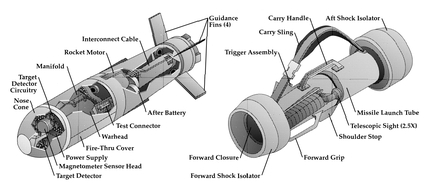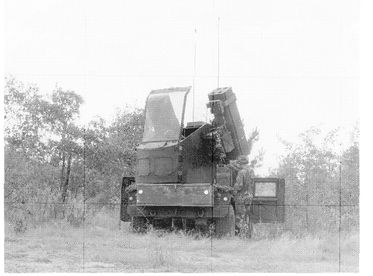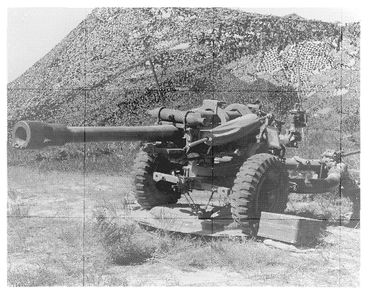Airborne (1997) (27 page)
Authors: Tom Clancy


A cutaway of the Lockheed Martin Loral Anti-Tank Missile.
JACK RYAN ENTERPRISES, LTD., BY LAURA ALPHER
FIM-92 Stinger/Avenger Surface-to-Air Missile SystemIs it possible for a weapon system to have such great value on the battlefield that it actually turns the political tide of a war? If so, the man-portable Stinger SAM is just such a system. In the 1980s the Reagan Administration made the decision to supply advanced Stinger man-portable surface-to-air missiles to the Mujahadeen rebels fighting the occupying Soviet armies in Afghanistan. Several years later, the Soviets withdrew their forces—defeated. Many in both America and the former Soviet Union firmly believe that if any single factor contributed to this withdrawal, it was the fact that the Russian helicopters and aircraft were unable to fly unhindered and gain control of the air in such a fashion as to provide support for their troops on the ground. Stingers in the hands of the Mujahadeen were the reason.
What type of weapon can have this type of impact? Well, the Stinger missile was designed to replace the Redeye man-portable SAM system which entered service with the U.S. military in 1967. The problem with the Redeye was that it was a “tail-chase” weapon, which meant that the Redeye’s infrared seeker needed a very hot heat source to home in on in order to lock onto its target. This was usually possible only when chasing after the heat plume coming from the rear of a jet’s engine. Unfortunately, soldiers usually only see the rear of an enemy aircraft’s jet
after
it drops its bombs onto the target. Thus the Redeye could usually engage the aircraft only after it was too late. Another disadvantage of the Redeye system was that it could only attack aircraft that were flying Mach 1. Thus, if an enemy pilot wanted to escape a Redeye, all he needed to do was speed up. A final problem for Redeye was that it was a very easy missile to decoy. Even as the Redeye began to enter service in 1967, the Army and Marine Corps were aware that a somewhat more advanced man-portable SAM was needed. Design, development, and testing of a Redeye replacement took nearly a decade. It was worth the wait, however, and the result was the FIM-92 Stinger missile, which began to enter service in 1979.
after
it drops its bombs onto the target. Thus the Redeye could usually engage the aircraft only after it was too late. Another disadvantage of the Redeye system was that it could only attack aircraft that were flying Mach 1. Thus, if an enemy pilot wanted to escape a Redeye, all he needed to do was speed up. A final problem for Redeye was that it was a very easy missile to decoy. Even as the Redeye began to enter service in 1967, the Army and Marine Corps were aware that a somewhat more advanced man-portable SAM was needed. Design, development, and testing of a Redeye replacement took nearly a decade. It was worth the wait, however, and the result was the FIM-92 Stinger missile, which began to enter service in 1979.
The Stinger missile, manufactured by Hughes Missile System Company, is a truly incredible system which has been combat-proven time and time again. The system itself, sometimes referred to as MANPADS Stinger (Man-Portable Air-Defense System), consists of a fiberglass launcher assembly with missile, a grip stock, an argon gas-charged Battery/Coolant Unit (BCU), and an Identification Friend or Foe (IFF) Interrogator. The FIM-92 missile has a two-stage solid-propellant rocket motor with different types of infrared and/or ultraviolet guidance systems fitted for subsequent models of the missile (FIM-92A, 92B, 92C, etc.).
Stinger MANPADS are usually accompanied by a crew chief, a gunner, and some type of vehicle carrying extra Stinger reloads (often an HMMWV). Once a target is sighted, the gunner can interrogate it using the IFF transponder to establish if it is hostile. Seven tenths of a second after the IFF switch is pressed, an audible tone will inform the gunner if the target is friend or foe. Should the target prove hostile, the gunner can activate the system by energizing the BCU with the impulse generator switch. When sufficient UV/IR energy is received to get a lock-on, another audible signal indicates that the missile is ready for launch. The gunner then depresses the firing trigger and less than two seconds later, the ejector motor has ignited and the missile is on its way. Once Stinger has been launched, it is very difficult to decoy. This is especially true of later versions of the missile, which are highly jam- and decoy-resistant. After the entire launch sequence, the MANPADS crew can reload and engage another target almost immediately. The only drawback is that MANPADS cannot fire on the move.
To remedy this problem the Army and Marine Corps began buying the Avenger Pedestal-Mounted Stinger system. Manufactured by Boeing Defense and Space Group, the Avenger is the first successful fire-on-the-move SAM system to enter production. It combines the technology of the Stinger missile with the speed and mobility of the HMMWV chassis. The system has eight missiles fitted in a turret mounted on the Hummer. The system is highly mobile and can be carried into the field by transport aircraft as small as a C-130, as well as CH-46E and CH-47D helicopters. The entire system is somewhat more capable than the Stinger MANPADS system because the vehicle allows more capable targeting equipment to be carried. Examples of this are a low-cost FLIR sensor, an eye-safe laser range finder, and a heads-up optical sight. Another interesting capability of the Avenger is its ability to allow the crew to engage targets from remote positions over 150 feet/45.7 meters away from the fire unit by using a remote-control system. All in all, the Stinger MANPADS and Avenger systems provide an invaluable antiaircraft capability to airborne troops who otherwise would have to rely upon friendly aircraft and long-range SAMs (like the Patriot) to protect them. Those systems may not always be available when the 82nd lands. The Stinger/Avenger system will be.
An Avenger Surface-to-Air Missile (SAM) system. Equipped with eight Stinger Missiles and a .50-calibre machine gun, the Avenger augments the man-portable Stinger MANPAD units in Army Air Defense Units.
JOHN D. GRESHAM

A word should also be mentioned here about another new missile system known as EFOG-M or Enhanced Fiber Optic Guided Missile. It was originally known as N-LOS (Non-Line-of-Sight). The name was later changed to FOG-M, and then the program was canceled in 1990. It was revived a few years later, and has recently been given the name EFOG-M. The EFOG-M would be capable of attacking both ground and air targets using a fiber-optic data link system, with TV or Imaging Infrared as the main guidance package. The proposed missile would have a range of about 15 km/9.3 mi, and would be carried by a modified HMMWV vehicle. Current plans call for Raytheon Missile Systems, EFOG-M’s prime contractor, to manufacture sixteen fire units and three hundred missiles under the technology demonstrator phase. If the system is successful, it may begin to replace the Avenger and TOW systems sometime in the next century.
Big Guns: Airborne Field ArtilleryArtillery has always been a vital part of airborne operations, and its importance is still growing. With the cancellation of the AGS and retirement of the Sheridan light tank, tube artillery is the only large gun system left in airborne service. Airborne artillery units are different from their counterparts in other Army organizations. This is because they too drop out of the sky, and have to help the paratroops fight their way out of the drop zone. This means that they may have to do direct fire missions against enemy targets over open sights. This is almost unheard of in normal artillery units. At the same time, airborne artillery utilizes only the lightest and most portable of gun systems, so that as many tubes as possible can be delivered to the battlefield. These guns are the subjects of our next exploration.
M-119 105mm HowitzerThe M-119 105mm light howitzer is probably the last gun of its caliber that will ever be deployed in the U.S. military. Don’t plan on seeing the M-119 going into retirement, though, because its gunners and the units they support really love this system. Lightweight enough to be towed by a Hummer or slung from a helicopter, it is the most portable artillery system in the world other than mortars.
The development history for the M-119 actually started over thirty years ago in Great Britain. The idea for the M-119 was conceived way back in 1965 when the British Army realized that they would soon need a new 105mm light gun. After nearly a decade of development, the L118 Light Gun, manufactured by Royal Ordnance of the UK, entered service with Britain’s Army in 1974. This event went almost unnoticed in the United States Army, which was busy withdrawing its forces from Vietnam, and dealing with some very serious morale problems. At the time, American artillery officers felt that their current 105mm tube artillery systems, the M-101 and M-102, suited them just fine. This may have been true then, but as the years passed, so too did the U.S. Army’s requirements change.
When the U.S. Army finally decided to go shopping for a new light field gun, the L118 was their obvious choice for a number of reasons. First, it was extremely light and could be carried easily by a medium-lift helicopter or towed by a truck. Secondly, it was combat-proven in the Falklands War and had performed exceedingly well there. Lastly, and perhaps most importantly, there would be no major development costs that the U.S. Army would have to shell out in order to develop their next-generation gun. If they bought the Royal Ordnance L118 105mm howitzer, they would be buying it “off the shelf” and saving a lot of money in the process. After evaluating the British gun for over a year, the decision to purchase an “Americanized” version of the L118 was finally made in 1986. The new artillery system would, except for the first 150 units, be manufactured under license in the U.S. as the M119 by the Watervliet Arsenal in New York and the Rock Island Arsenal in Illinois.
Since entering service with the U.S. Army, the M-119 has performed superbly. The entire system weighs only two tons, and is capable of firing the entire range of NATO-compatible 105mm shells including high-explosive, smoke, illumination, and HE rocket-assisted projectiles. The entire crew is made up of only seven soldiers, and the maximum range for the M-119 is 14.3 km/8.9 mi using conventional HE ammunition, and 19.5 km/12.1 mi using rocket-assisted projectiles. Because the M-119 is easily transported by a UH-60 Blackhawk helicopter and can be towed by an HMMWV truck, it is a perfect fit to fill the needs of the XVIII Airborne Corps. The 82nd has an entire battalion of these weapons (three batteries of six guns each) assigned to each of the three brigades in the division.
An emplaced M 119 lightweight 105mm Howitzer of the 82nd Airborne Division’s Artillery Brigade. Light enough to be carried as a sling load, eighteen M119s equip each of the Brigade’s three Battalions.
JOHN D. GRESHAM

The heaviest tube artillery now used by the units of the XVIII Airborne Corps is the 155mm M-198. The M-198 field gun replaced the old M-114 in American service. There was much resistance to replacing this design with the newer (and heavier) M-198. However, the weight increases were more than worth it since the M-198 has much greater range than the M-114. The idea for the M-198 began in the late 1960s. Within two years, several prototypes had been delivered, and in 1978 the Rock Island Arsenal began to manufacture the M-198. Over one thousand M-198s are currently in service with the U.S. Army and Marine Corps.
While it is over three times as heavy as the M-119A1 (4,000 1b/1,800 kg versus 15,740 1b/6,961 kg), the M-198 is still helicopter-transportable, and can be carried by either the Army’s CH-47 Chinook or the Marine Ch-53E Super Stallion. The M-198 gun can also be towed by the M939A2 5-ton truck. The crew for the M-198 is composed of nine soldiers. The gun can hurl a rocket-assisted shell over 18.8 mi/30 km, and can toss a conventional projectile some 13.9 mi/22.4 km. The M-198 is capable of firing four rpm, and the lethal burst radius against exposed troops for a regular HE shell is over 150 feet/45.7 meters. In addition to the normal HE rounds, the M-198 can fire:
•
Antitank Mines
—The M-198 can fire both the M741 and the M718 rounds, each of which carry nine antitank mines.
Antitank Mines
—The M-198 can fire both the M741 and the M718 rounds, each of which carry nine antitank mines.
•
Laser-Guided Projectiles
—The M-198 is also capable of firing the laser-guided Copperhead antitank round (M712) to a range of 16.4 km/10.2 mi. This round is highly accurate and extremely effective, attacking unsuspecting main battle tanks and other types of armored vehicles. Unfortunately, due to their extraordinary cost, only a few thousand were ever produced.
Laser-Guided Projectiles
—The M-198 is also capable of firing the laser-guided Copperhead antitank round (M712) to a range of 16.4 km/10.2 mi. This round is highly accurate and extremely effective, attacking unsuspecting main battle tanks and other types of armored vehicles. Unfortunately, due to their extraordinary cost, only a few thousand were ever produced.
•
HE/Antipersonnel/Armor
—Several
types of HE
/antipersonnel/- armor rounds are available: including the M483, which contains eighty-eight dual-purpose grenades; the M692, which contains thirty-six antipersonnel mines; and the M731, which contains a similar number of antiarmor mines. The Dual-Purpose Improved Conventional Munition (DPICM) can also be fired by M-198s.
HE/Antipersonnel/Armor
—Several
types of HE
/antipersonnel/- armor rounds are available: including the M483, which contains eighty-eight dual-purpose grenades; the M692, which contains thirty-six antipersonnel mines; and the M731, which contains a similar number of antiarmor mines. The Dual-Purpose Improved Conventional Munition (DPICM) can also be fired by M-198s.
•
Other Rounds
—The M-198 can also fire illumination and smoke rounds, and future plans may also enable the M-198 to carry powerful SADARM (Sense And Destroy Armor) munitions, which will give the 155mm the capability to attack heavy armor formations without the need of a forward observer with a laser designator.
Other Rounds
—The M-198 can also fire illumination and smoke rounds, and future plans may also enable the M-198 to carry powerful SADARM (Sense And Destroy Armor) munitions, which will give the 155mm the capability to attack heavy armor formations without the need of a forward observer with a laser designator.
Other books
Forgiving Reed (Southern Boys #1) by C. A. Harms
Saving Savannah by Sandra Hill
Worth the Wait by Caitlin Ricci & Cari Z.
The Betrayal by Jerry B. Jenkins
As I Die Lying by Scott Nicholson
StarFight 1: Battlestar by T. Jackson King
Clade by Mark Budz
Shady: MC Romance by Harley McRide
Alien Dragon by Sophie Stern
Mr. Monk is a Mess by Goldberg, Lee